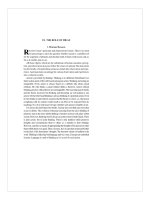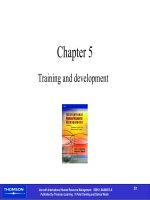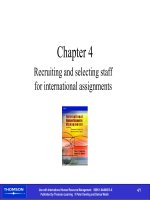International human resource management - Chapter 9 pptx
Bạn đang xem bản rút gọn của tài liệu. Xem và tải ngay bản đầy đủ của tài liệu tại đây (216.41 KB, 48 trang )
Use with International Human Resource Management ISBN 1-84480013-X
Published by Thomson Learning © Peter Dowling and Denice Welch
Chapter 9
Industrial relations
Use with International Human Resource Management ISBN 1-84480013-X
Published by Thomson Learning © Peter Dowling and Denice Welch
Chapter objectives
•
Discuss key issues in industrial relations and the policies and
practices of multinationals.
•
Examine the potential constraints that trade unions may have on
multinationals.
•
Outline key concerns for trade unions.
•
Discuss recent trends and issues in the global workforce context.
•
Discuss the formation of regional economic zones such as the
European Union.
The focus of the preceding chapters has been on managing and
supporting international assignments, post-assignment and the
issues in subsidiary operations. In this chapter we:
Use with International Human Resource Management ISBN 1-84480013-X
Published by Thomson Learning © Peter Dowling and Denice Welch
Introduction
•
We need to consider some general points about the field of
international industrial relations. First, it is important to realize
that it is difficult to compare industrial relations systems and
behavior across national boundaries; an industrial relations
concept may change considerably when translated from one
industrial relations context to another.
•
Cross-national differences also emerge as to the objectives of
the collective bargaining process and the enforceability of
collective agreements.
(cont.)
Use with International Human Resource Management ISBN 1-84480013-X
Published by Thomson Learning © Peter Dowling and Denice Welch
Introduction (cont.)
•
Schregle has observed:
“A comparative study of industrial relations shows that
industrial relations phenomena are a very faithful expression
of the society in which they operate, of its characteristic
features and of the power relationships between different
interest groups. Industrial relations cannot be understood
without an understanding of the way in which rules are
established and implemented and decisions are made in the
society concerned.”
(cont.)
Use with International Human Resource Management ISBN 1-84480013-X
Published by Thomson Learning © Peter Dowling and Denice Welch
Introduction (cont.)
•
Poole has identified several factors that may underlie these
historical differences:
–
the mode of technology and industrial organization at critical stages of
union development
–
methods of union regulation by government
–
ideological divisions within the trade union movement
–
the influence of religious organizations on trade union development
–
managerial strategies for labor relations in large corporations.
(cont.)
Use with International Human Resource Management ISBN 1-84480013-X
Published by Thomson Learning © Peter Dowling and Denice Welch
Introduction (cont.)
•
Union structures differ considerably among Western countries.
These include industrial unions, which represent all grades of
employees in an industry; craft unions, which are based on
skilled occupational groupings across industries; conglomerate
unions, which represent members in more than one industry;
and general unions, which are open to almost all employees in
a given country.
(cont.)
Use with International Human Resource Management ISBN 1-84480013-X
Published by Thomson Learning © Peter Dowling and Denice Welch
Table 9-1: Trade union structure in leading western
industrial societies
Introduction (cont.)
Use with International Human Resource Management ISBN 1-84480013-X
Published by Thomson Learning © Peter Dowling and Denice Welch
Introduction (cont.)
•
These differences in union structures have had a major influence
on the collective bargaining process in Western countries. Some
changes in union structure are evident over time.
•
The lack of familiarity of multinational managers with local
industrial and political conditions has sometimes needlessly
worsened a conflict that a local firm would have been likely to
resolve.
•
Increasingly, multinationals are recognizing this shortcoming
and admitting that industrial relations policies must be flexible
enough to adapt to local requirements.
•
This is evidently an enduring approach, even in firms that
follow a non-union labor relations strategy where possible.
Use with International Human Resource Management ISBN 1-84480013-X
Published by Thomson Learning © Peter Dowling and Denice Welch
Key issues in international
industrial relations
•
Industrial relations policies and practices of multinational firms
–
Because national differences in economic, political and legal systems
produce markedly different industrial relations systems across countries,
multinationals generally delegate the management of industrial relations
to their foreign subsidiaries. However, a policy of decentralization does
not keep corporate headquarters from exercising some coordination over
industrial relations strategy.
–
Generally, corporate headquarters will become involved in or oversee
labor agreements made by foreign subsidiaries because these agreements
may affect the international plans of the firm and/or create precedents for
negotiations in other countries.
–
Multinational headquarters involvement in industrial relations is
influenced by several factors, as detailed below.
(cont.)
Use with International Human Resource Management ISBN 1-84480013-X
Published by Thomson Learning © Peter Dowling and Denice Welch
Key issues in international
industrial relations (cont.)
•
Industrial relations policies and practices of multinational firms
(cont.)
–
The degree of inter-subsidiary production integration.
•
High degree of integration was found to be the most important factor leading
to the centralization of the industrial relations function within the firms
studied.
•
Industrial relations throughout a system become of direct importance to
corporate headquarters when transnational sourcing patterns have been
developed, that is, when a subsidiary in one country relies on another foreign
subsidiary as a source of components or as a user of its output.
•
In this context, a coordinated industrial relations policy is one of the key
factors in a successful global production strategy.
Use with International Human Resource Management ISBN 1-84480013-X
Published by Thomson Learning © Peter Dowling and Denice Welch
Key issues in international
industrial relations (cont.)
•
Industrial relations policies and practices of multinational firms
(cont.)
–
Nationality of ownership of the subsidiary.
•
A number of studies have revealed that US firms tend to exercise greater
centralized control over labor relations than do British or other European firms.
•
US firms tend to place greater emphasis on formal management controls and a
close reporting system (particularly within the area of financial control) to ensure
that planning targets are met.
•
Foreign-owned multinationals in Britain prefer single-employer bargaining (rather
than involving an employer association), and are more likely than British firms to
assert managerial prerogative on matters of labor utilization.
•
Further, Hamill found US-owned subsidiaries to be much more centralized in labor
relations decision making than British-owned. Hamill attributed this difference in
management procedures to the more integrated nature of US firms, the greater
divergence between British and US labor relations systems than between British
and other European systems, and the more ethnocentric managerial style of US
firms.
Use with International Human Resource Management ISBN 1-84480013-X
Published by Thomson Learning © Peter Dowling and Denice Welch
Key issues in international
industrial relations (cont.)
•
Industrial relations policies and practices of multinational firms
(cont.)
–
International human resource management approach.
•
The various international human resource management approaches utilized
by multinationals; these have implications for international industrial
relations.
•
An ethnocentric predisposition is more likely to be associated with various
forms of industrial relations conflict.
•
Conversely, it has been shown that more geocentric firms will bear more
influence on host-country industrial relations systems, owing to their greater
propensity to participate in local events.
Use with International Human Resource Management ISBN 1-84480013-X
Published by Thomson Learning © Peter Dowling and Denice Welch
Key issues in international
industrial relations (cont.)
•
Industrial relations policies and practices of multinational firms
(cont.)
–
MNE prior experience in industrial relations.
•
European firms have tended to deal with industrial unions at industry level
(frequently via employer associations) rather than at firm level.
•
The opposite is more typical for US firms. In the USA, employer
associations have not played a key role in the industrial relations system, and
firm-based industrial relations policies are the norm.
Use with International Human Resource Management ISBN 1-84480013-X
Published by Thomson Learning © Peter Dowling and Denice Welch
Key issues in international
industrial relations (cont.)
•
Industrial relations policies and practices of multinational firms
(cont.)
–
Subsidiary characteristics.
•
Research has identified a number of subsidiary characteristics to be relevant
to centralization of industrial relations.
•
First, subsidiaries that are formed through acquisition of well-established
indigenous firms tend to be given much more autonomy over industrial
relations than are greenfield sites set up by a multinational firm.
•
Second, according to Enderwick, greater intervention would be expected
when the subsidiary is of key strategic importance to the firm and the
subsidiary is young.
Use with International Human Resource Management ISBN 1-84480013-X
Published by Thomson Learning © Peter Dowling and Denice Welch
Key issues in international
industrial relations (cont.)
•
Industrial relations policies and practices of multinational firms
(cont.)
–
Subsidiary characteristics ( c ont.).
•
Third, where the parent firm is a significant source of operating or
investment funds for the subsidiary, that is, where the subsidiary is more
dependent on headquarters for resources, there will tend to be increased
corporate involvement in industrial relations and human resource
management.
•
Finally, poor subsidiary performance tends to be accompanied by increased
corporate involvement in industrial relations. Where poor performance is due
to industrial relations problems, multinationals tend to attempt to introduce
parent-country industrial relations practices aimed at reducing industrial
unrest or increasing productivity.
Use with International Human Resource Management ISBN 1-84480013-X
Published by Thomson Learning © Peter Dowling and Denice Welch
Key issues in international
industrial relations (cont.)
•
Industrial relations policies and practices of multinational firms
(cont.)
–
Characteristics of the home product market.
•
An important factor is the extent of the home product market.
•
If domestic sales are large relative to overseas operations (as is the case with
many US firms), it is more likely that overseas operations will be regarded
by the parent firm as an extension of domestic operations.
•
This is not the case for many European firms, whose international operations
represent the major part of their business.
•
Lack of a large home market is a strong incentive to adapt to host-country
institutions and norms.
Use with International Human Resource Management ISBN 1-84480013-X
Published by Thomson Learning © Peter Dowling and Denice Welch
Key issues in international
industrial relations (cont.)
•
Industrial relations policies and practices of multinational firms
(cont.)
–
Characteristics of the home product market (cont.) .
•
Since the implementation of the Single European Market in 1993, there has
been growth in large European-scale companies (formed via acquisition or
joint ventures) that centralize management organization and strategic
decision-making.
•
However, processes of operational decentralization with regard to industrial
relations are also evident.
Use with International Human Resource Management ISBN 1-84480013-X
Published by Thomson Learning © Peter Dowling and Denice Welch
Key issues in international
industrial relations (cont.)
•
Industrial relations policies and practices of multinational firms
(cont.)
–
Management attitudes towards unions.
•
An additional important factor is that of management attitudes or ideology
concerning unions.
•
Knowledge of management attitudes concerning unions may provide a more
complete explanation of multinational industrial relations behavior than
could be obtained by relying solely on a rational economic model.
•
Thus, management attitudes should also be considered in any explanation of
managerial behavior along with such factors as market forces and strategic
choices.
•
Denmark has the highest level of union membership, the USA has the second
lowest and France has the lowest in the Western world.
Use with International Human Resource Management ISBN 1-84480013-X
Published by Thomson Learning © Peter Dowling and Denice Welch
Key issues in international
industrial relations (cont.)
•
Industrial relations policies and practices of multinational firms
(cont.)
–
Although there are several problems inherent in data collection for a
crossnational comparison of union-density rates, several theories have
been suggested to explain the variations among countries. Such theories
consider economic factors such as wages, prices and unemployment
levels, social factors such as public support for unions and political
factors. In addition, studies indicate that the strategies utilized by labor,
management and governments are particularly important.
Use with International Human Resource Management ISBN 1-84480013-X
Published by Thomson Learning © Peter Dowling and Denice Welch
Key issues in international
industrial relations (cont.)
•
Industrial relations policies and practices of multinational firms
(cont.)
–
Another key issue in international industrial relations is industrial
disputes. Hamill examined strike-proneness of multinational subsidiaries
and indigenous firms in Britain across three industries. Strike proneness
was measured via three variables – strike frequency, strike size and strike
duration. There was no difference across the two groups of firms with
regard to strike frequency, but multinational subsidiaries did experience
larger and longer strikes than local firms. Hamill suggests that this
difference indicates that foreign-owned firms may be under less financial
pressure to settle a strike quickly than local firms – possibly because they
can switch production out of the country.
Use with International Human Resource Management ISBN 1-84480013-X
Published by Thomson Learning © Peter Dowling and Denice Welch
Key issues in international
industrial relations (cont.)
•
Industrial relations policies and practices of multinational firms
(cont.)
–
Overall, it is evident that international industrial relations are influenced
by a broad range of factors. Commenting on the overall results of his
research, Hamill concluded that:
“General statements cannot be applied to the organization of the labor
relations function within MNEs. Rather, different MNEs adopt different
labor relations strategies in relation to the environmental factors peculiar
to each firm. In other words, it is the type of multinational under
consideration which is important rather than multinationality itself.”
Use with International Human Resource Management ISBN 1-84480013-X
Published by Thomson Learning © Peter Dowling and Denice Welch
Trade unions and international
industrial relations
•
Trade unions may limit the strategic choices of multinationals in
three ways: (1) by influencing wage levels to the extent that cost
structures may become uncompetitive; (2) by constraining the
ability of multinationals to vary employment levels at will; and
(3) by hindering or preventing global integration of the
operations of multinationals.
–
Influencing wage levels.
•
Although the importance of labor costs relative to other costs is decreasing,
labor costs still play an important part in determining cost competitiveness in
most industries.
•
Multinationals that fail to manage their wage levels successfully will suffer
labor cost disadvantages that may narrow their strategic options.
Use with International Human Resource Management ISBN 1-84480013-X
Published by Thomson Learning © Peter Dowling and Denice Welch
Trade unions and international
industrial relations (cont.)
–
Constraining the ability of multinationals to vary employment levels
at will.
•
For many multinationals operating in Western Europe, Japan and Australia,
the inability to vary employment levels at will may be a more serious
problem than wage levels.
•
Many countries now have legislation that limits considerably the ability of
firms to carry out plant closure, redundancy or layoff programs unless it can
be shown that structural conditions make these employment losses
unavoidable.
•
Frequently, the process of showing the need for these programs is long and
drawnout.
•
Plant closure or redundancy legislation in many countries also frequently
specifies that firms must compensate redundant employees through specified
formulae such as 2 weeks’ pay for each year of service. In many countries,
payments for involuntary terminations are substantial, especially in
comparison with those in the USA.
Use with International Human Resource Management ISBN 1-84480013-X
Published by Thomson Learning © Peter Dowling and Denice Welch
Trade unions and international
industrial relations (cont.)
–
Constraining the ability of multinationals to vary employment levels
at will (cont.).
•
Trade unions may influence this process in two ways: by lobbying their own
national governments to introduce redundancy legislation, and by
encouraging regulation of multinationals by international organizations such
as the Organization for Economic Cooperation and Development (OECD).
•
Multinational managers who do not take these restrictions into account in
their strategic planning may well find their options severely limited. In fact,
recent evidence shows that multinationals are beginning to consider the
ability to dismiss employees to be one of the priorities when making
investment location decisions.
Use with International Human Resource Management ISBN 1-84480013-X
Published by Thomson Learning © Peter Dowling and Denice Welch
Trade unions and international
industrial relations (cont.)
–
Hindering or preventing global integration of the operations of
multinationals.
•
Many multinationals make a conscious decision not to integrate and
rationalize their operations to the most efficient degree, because to do so
could cause industrial and political problems.
•
General Motors as an example of this ‘sub-optimization of integration’. GM
was alleged in the early 1980s to have undertaken substantial investments in
Germany at the demand of the German metalworkers’ union (one of the
largest industrial unions in the Western world) in order to foster good
industrial relations in Germany. One observer of the world auto industry
suggested that car manufacturers were sub-optimizing their manufacturing
networks partly to placate trade unions and partly to provide redundancy in
sources to prevent localized social strife from paralysing their network.









